Financial Technology Report: Spring 2022, Bangor University
VerifiedAdded on 2023/06/10
|11
|3469
|99
Report
AI Summary
This report provides a comprehensive literature review on financial technology (FinTech), exploring its impact on the financial services industry. The report begins by defining FinTech and its role in innovation and disruption, examining how technology is changing the way financial institutions operate and interact with customers. It then delves into the concept of financial disintermediation, analyzing how FinTech is removing intermediaries like banks and brokers, and enabling direct investment. The report also investigates the regulatory landscape of FinTech, particularly in the UK, discussing the challenges and opportunities that arise from integrating technology into financial services, including the roles of the FCA and PRA. The analysis draws on a variety of sources, discussing the evolution and development of FinTech firms and the impact of technological advancements. The report also addresses the risks associated with FinTech, such as cyber security threats and the need for robust risk management strategies. The report concludes by summarizing the key findings and highlighting the ongoing evolution of FinTech and its implications for the future of financial services.
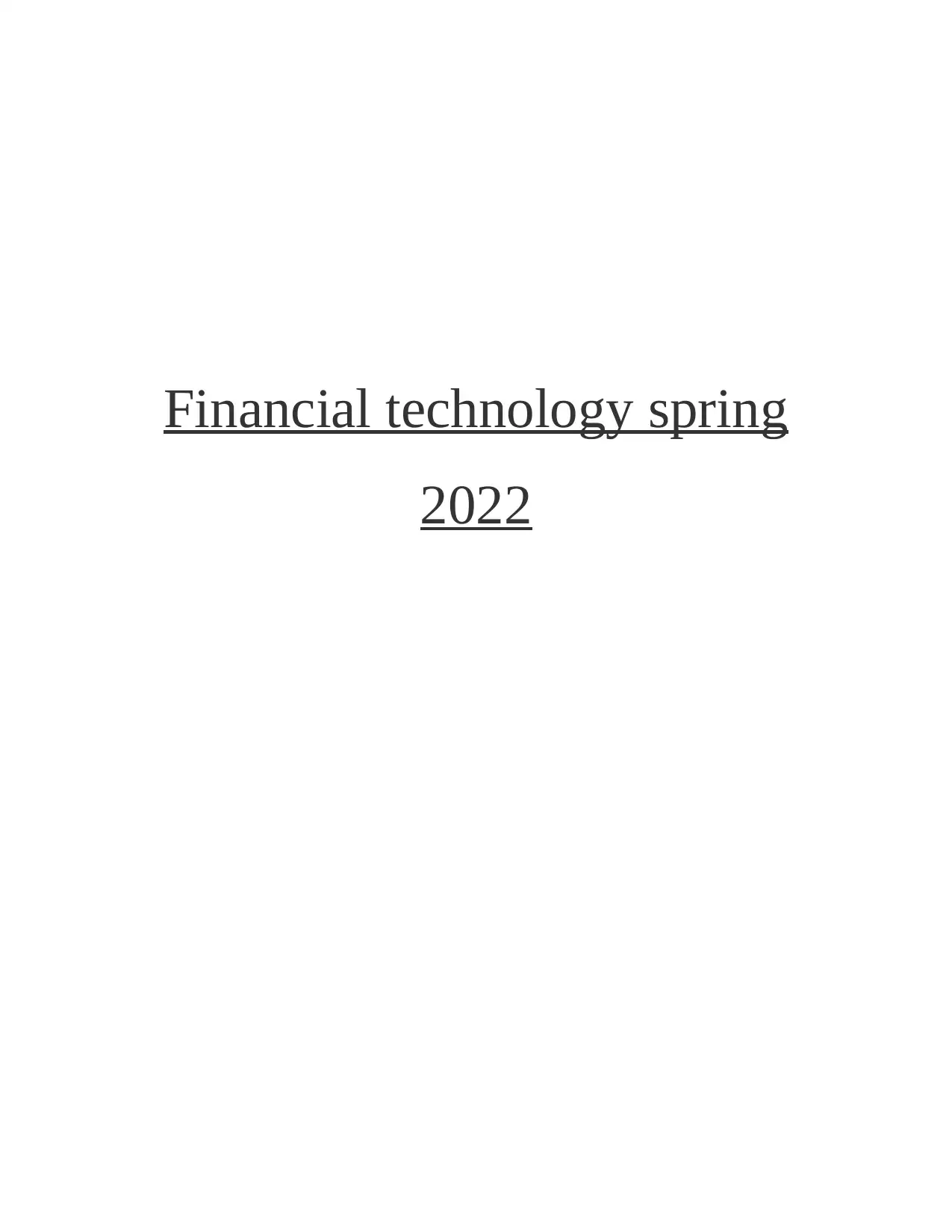
Financial technology spring
2022
2022
Paraphrase This Document
Need a fresh take? Get an instant paraphrase of this document with our AI Paraphraser
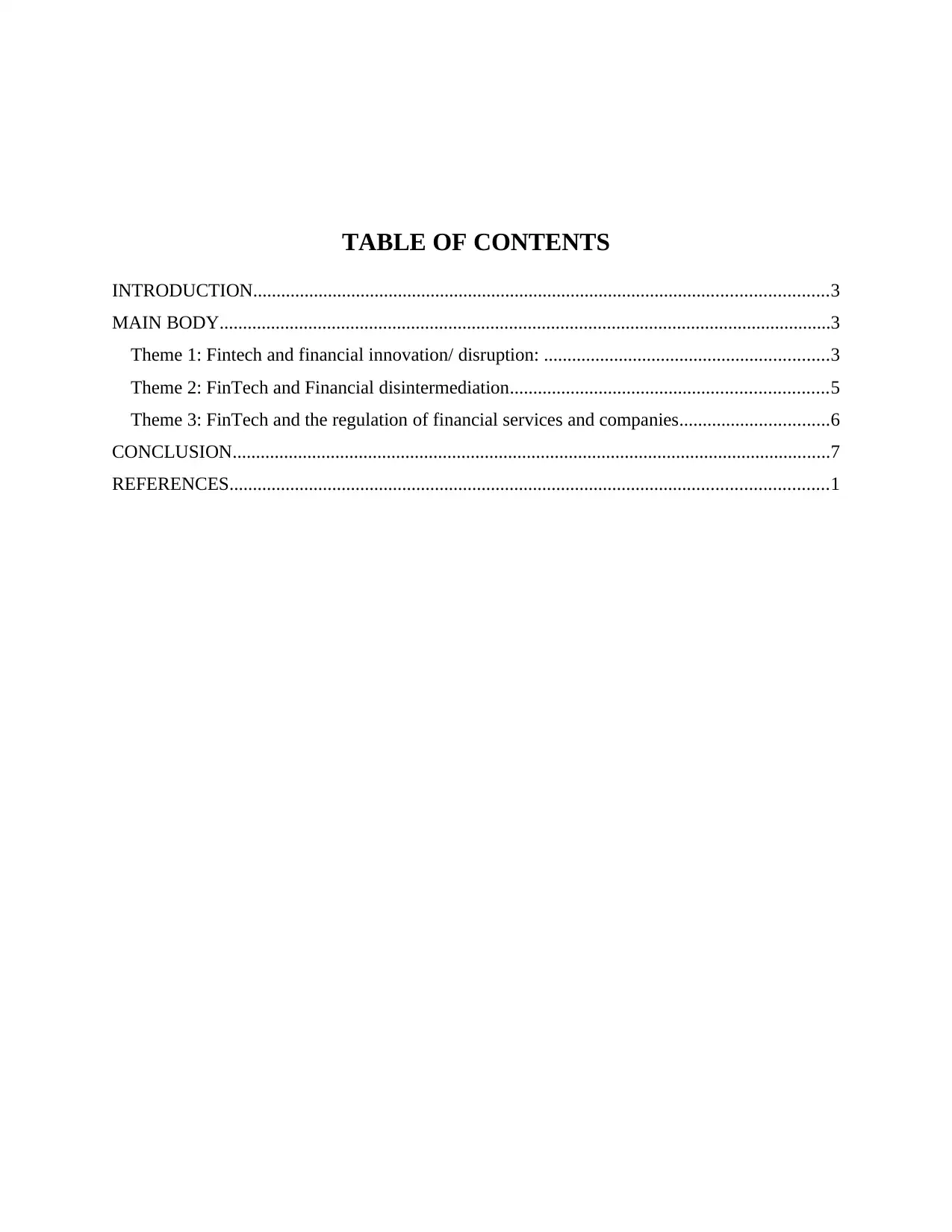
TABLE OF CONTENTS
INTRODUCTION...........................................................................................................................3
MAIN BODY...................................................................................................................................3
Theme 1: Fintech and financial innovation/ disruption: .............................................................3
Theme 2: FinTech and Financial disintermediation....................................................................5
Theme 3: FinTech and the regulation of financial services and companies................................6
CONCLUSION................................................................................................................................7
REFERENCES................................................................................................................................1
INTRODUCTION...........................................................................................................................3
MAIN BODY...................................................................................................................................3
Theme 1: Fintech and financial innovation/ disruption: .............................................................3
Theme 2: FinTech and Financial disintermediation....................................................................5
Theme 3: FinTech and the regulation of financial services and companies................................6
CONCLUSION................................................................................................................................7
REFERENCES................................................................................................................................1
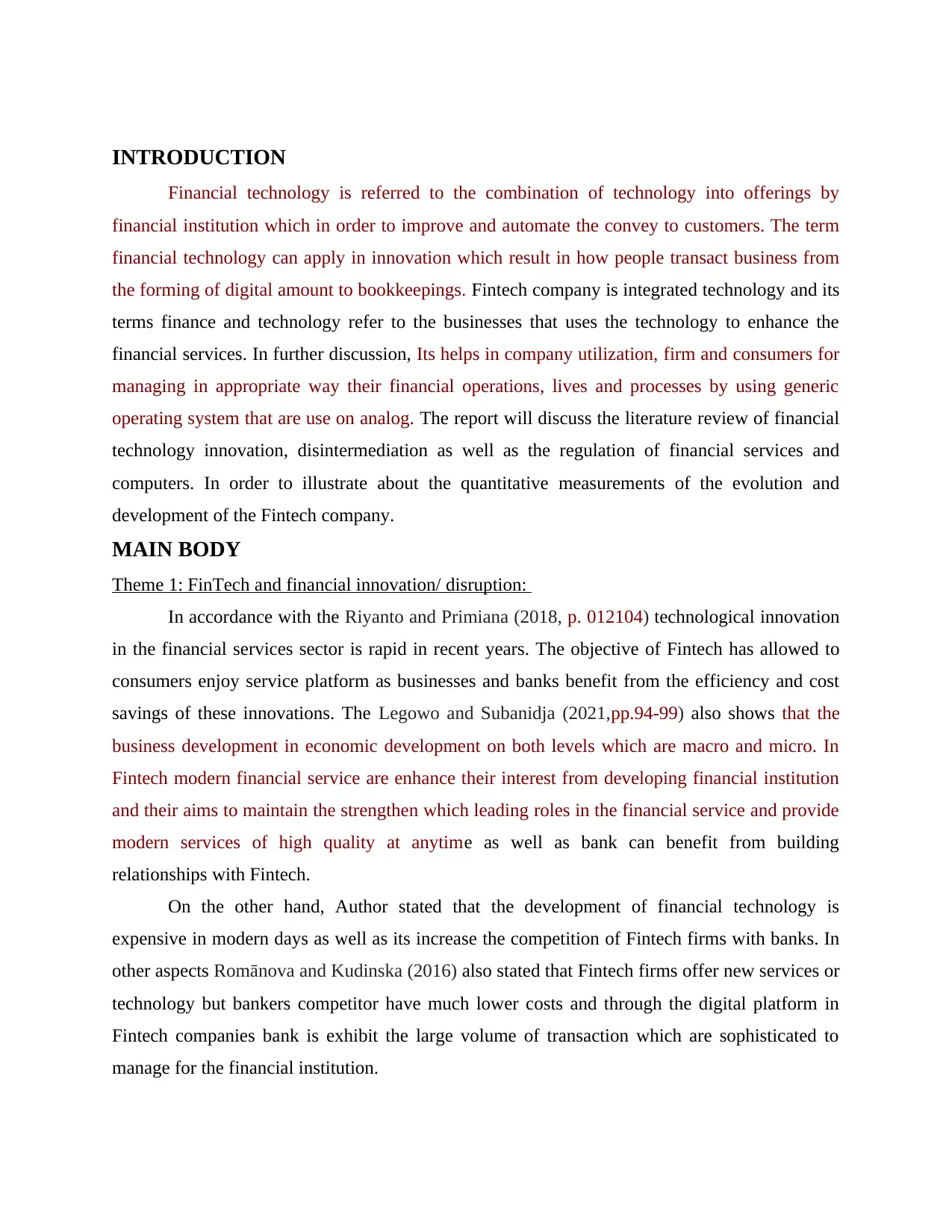
INTRODUCTION
Financial technology is referred to the combination of technology into offerings by
financial institution which in order to improve and automate the convey to customers. The term
financial technology can apply in innovation which result in how people transact business from
the forming of digital amount to bookkeepings. Fintech company is integrated technology and its
terms finance and technology refer to the businesses that uses the technology to enhance the
financial services. In further discussion, Its helps in company utilization, firm and consumers for
managing in appropriate way their financial operations, lives and processes by using generic
operating system that are use on analog. The report will discuss the literature review of financial
technology innovation, disintermediation as well as the regulation of financial services and
computers. In order to illustrate about the quantitative measurements of the evolution and
development of the Fintech company.
MAIN BODY
Theme 1: FinTech and financial innovation/ disruption:
In accordance with the Riyanto and Primiana (2018, p. 012104) technological innovation
in the financial services sector is rapid in recent years. The objective of Fintech has allowed to
consumers enjoy service platform as businesses and banks benefit from the efficiency and cost
savings of these innovations. The Legowo and Subanidja (2021,pp.94-99) also shows that the
business development in economic development on both levels which are macro and micro. In
Fintech modern financial service are enhance their interest from developing financial institution
and their aims to maintain the strengthen which leading roles in the financial service and provide
modern services of high quality at anytime as well as bank can benefit from building
relationships with Fintech.
On the other hand, Author stated that the development of financial technology is
expensive in modern days as well as its increase the competition of Fintech firms with banks. In
other aspects Romānova and Kudinska (2016) also stated that Fintech firms offer new services or
technology but bankers competitor have much lower costs and through the digital platform in
Fintech companies bank is exhibit the large volume of transaction which are sophisticated to
manage for the financial institution.
Financial technology is referred to the combination of technology into offerings by
financial institution which in order to improve and automate the convey to customers. The term
financial technology can apply in innovation which result in how people transact business from
the forming of digital amount to bookkeepings. Fintech company is integrated technology and its
terms finance and technology refer to the businesses that uses the technology to enhance the
financial services. In further discussion, Its helps in company utilization, firm and consumers for
managing in appropriate way their financial operations, lives and processes by using generic
operating system that are use on analog. The report will discuss the literature review of financial
technology innovation, disintermediation as well as the regulation of financial services and
computers. In order to illustrate about the quantitative measurements of the evolution and
development of the Fintech company.
MAIN BODY
Theme 1: FinTech and financial innovation/ disruption:
In accordance with the Riyanto and Primiana (2018, p. 012104) technological innovation
in the financial services sector is rapid in recent years. The objective of Fintech has allowed to
consumers enjoy service platform as businesses and banks benefit from the efficiency and cost
savings of these innovations. The Legowo and Subanidja (2021,pp.94-99) also shows that the
business development in economic development on both levels which are macro and micro. In
Fintech modern financial service are enhance their interest from developing financial institution
and their aims to maintain the strengthen which leading roles in the financial service and provide
modern services of high quality at anytime as well as bank can benefit from building
relationships with Fintech.
On the other hand, Author stated that the development of financial technology is
expensive in modern days as well as its increase the competition of Fintech firms with banks. In
other aspects Romānova and Kudinska (2016) also stated that Fintech firms offer new services or
technology but bankers competitor have much lower costs and through the digital platform in
Fintech companies bank is exhibit the large volume of transaction which are sophisticated to
manage for the financial institution.
⊘ This is a preview!⊘
Do you want full access?
Subscribe today to unlock all pages.

Trusted by 1+ million students worldwide
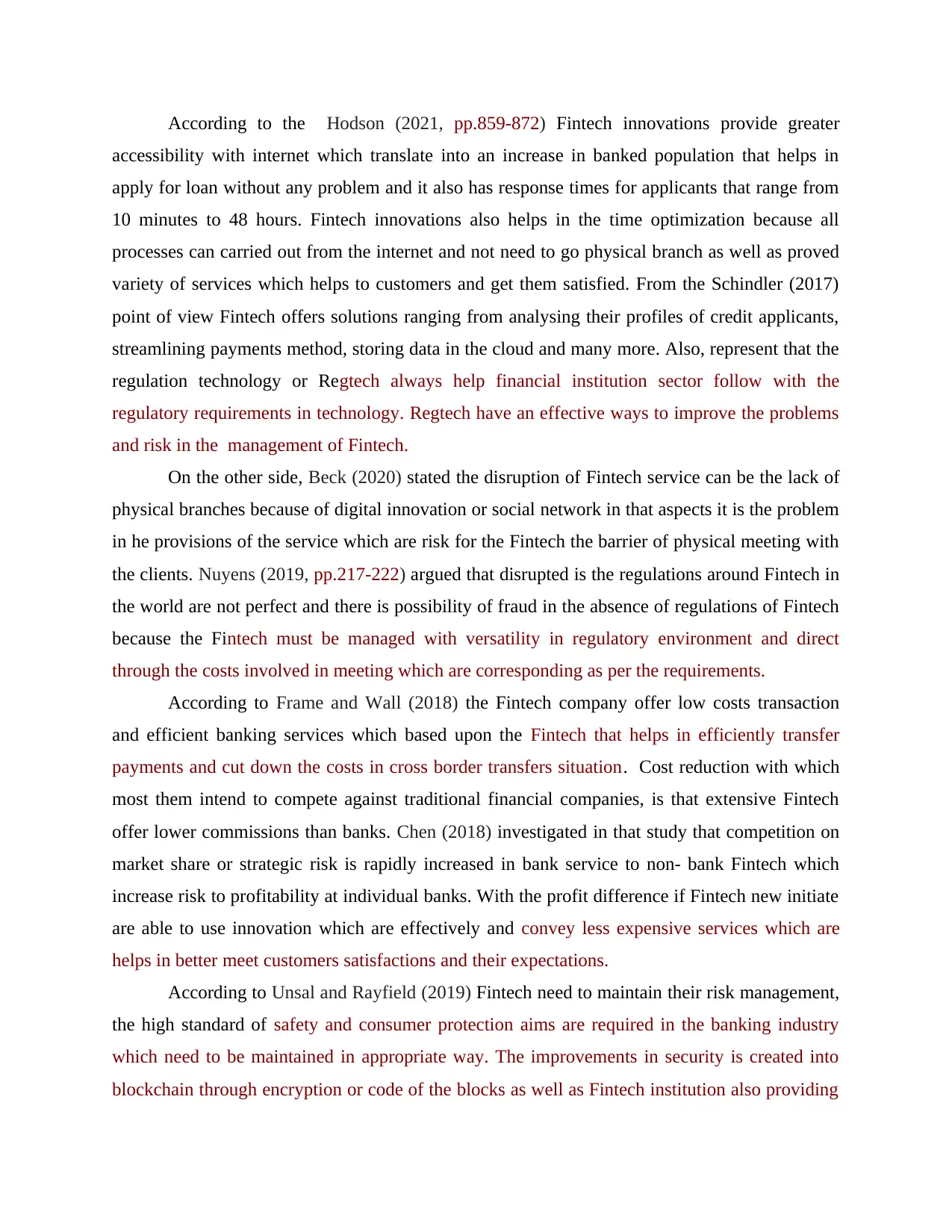
According to the Hodson (2021, pp.859-872) Fintech innovations provide greater
accessibility with internet which translate into an increase in banked population that helps in
apply for loan without any problem and it also has response times for applicants that range from
10 minutes to 48 hours. Fintech innovations also helps in the time optimization because all
processes can carried out from the internet and not need to go physical branch as well as proved
variety of services which helps to customers and get them satisfied. From the Schindler (2017)
point of view Fintech offers solutions ranging from analysing their profiles of credit applicants,
streamlining payments method, storing data in the cloud and many more. Also, represent that the
regulation technology or Regtech always help financial institution sector follow with the
regulatory requirements in technology. Regtech have an effective ways to improve the problems
and risk in the management of Fintech.
On the other side, Beck (2020) stated the disruption of Fintech service can be the lack of
physical branches because of digital innovation or social network in that aspects it is the problem
in he provisions of the service which are risk for the Fintech the barrier of physical meeting with
the clients. Nuyens (2019, pp.217-222) argued that disrupted is the regulations around Fintech in
the world are not perfect and there is possibility of fraud in the absence of regulations of Fintech
because the Fintech must be managed with versatility in regulatory environment and direct
through the costs involved in meeting which are corresponding as per the requirements.
According to Frame and Wall (2018) the Fintech company offer low costs transaction
and efficient banking services which based upon the Fintech that helps in efficiently transfer
payments and cut down the costs in cross border transfers situation. Cost reduction with which
most them intend to compete against traditional financial companies, is that extensive Fintech
offer lower commissions than banks. Chen (2018) investigated in that study that competition on
market share or strategic risk is rapidly increased in bank service to non- bank Fintech which
increase risk to profitability at individual banks. With the profit difference if Fintech new initiate
are able to use innovation which are effectively and convey less expensive services which are
helps in better meet customers satisfactions and their expectations.
According to Unsal and Rayfield (2019) Fintech need to maintain their risk management,
the high standard of safety and consumer protection aims are required in the banking industry
which need to be maintained in appropriate way. The improvements in security is created into
blockchain through encryption or code of the blocks as well as Fintech institution also providing
accessibility with internet which translate into an increase in banked population that helps in
apply for loan without any problem and it also has response times for applicants that range from
10 minutes to 48 hours. Fintech innovations also helps in the time optimization because all
processes can carried out from the internet and not need to go physical branch as well as proved
variety of services which helps to customers and get them satisfied. From the Schindler (2017)
point of view Fintech offers solutions ranging from analysing their profiles of credit applicants,
streamlining payments method, storing data in the cloud and many more. Also, represent that the
regulation technology or Regtech always help financial institution sector follow with the
regulatory requirements in technology. Regtech have an effective ways to improve the problems
and risk in the management of Fintech.
On the other side, Beck (2020) stated the disruption of Fintech service can be the lack of
physical branches because of digital innovation or social network in that aspects it is the problem
in he provisions of the service which are risk for the Fintech the barrier of physical meeting with
the clients. Nuyens (2019, pp.217-222) argued that disrupted is the regulations around Fintech in
the world are not perfect and there is possibility of fraud in the absence of regulations of Fintech
because the Fintech must be managed with versatility in regulatory environment and direct
through the costs involved in meeting which are corresponding as per the requirements.
According to Frame and Wall (2018) the Fintech company offer low costs transaction
and efficient banking services which based upon the Fintech that helps in efficiently transfer
payments and cut down the costs in cross border transfers situation. Cost reduction with which
most them intend to compete against traditional financial companies, is that extensive Fintech
offer lower commissions than banks. Chen (2018) investigated in that study that competition on
market share or strategic risk is rapidly increased in bank service to non- bank Fintech which
increase risk to profitability at individual banks. With the profit difference if Fintech new initiate
are able to use innovation which are effectively and convey less expensive services which are
helps in better meet customers satisfactions and their expectations.
According to Unsal and Rayfield (2019) Fintech need to maintain their risk management,
the high standard of safety and consumer protection aims are required in the banking industry
which need to be maintained in appropriate way. The improvements in security is created into
blockchain through encryption or code of the blocks as well as Fintech institution also providing
Paraphrase This Document
Need a fresh take? Get an instant paraphrase of this document with our AI Paraphraser
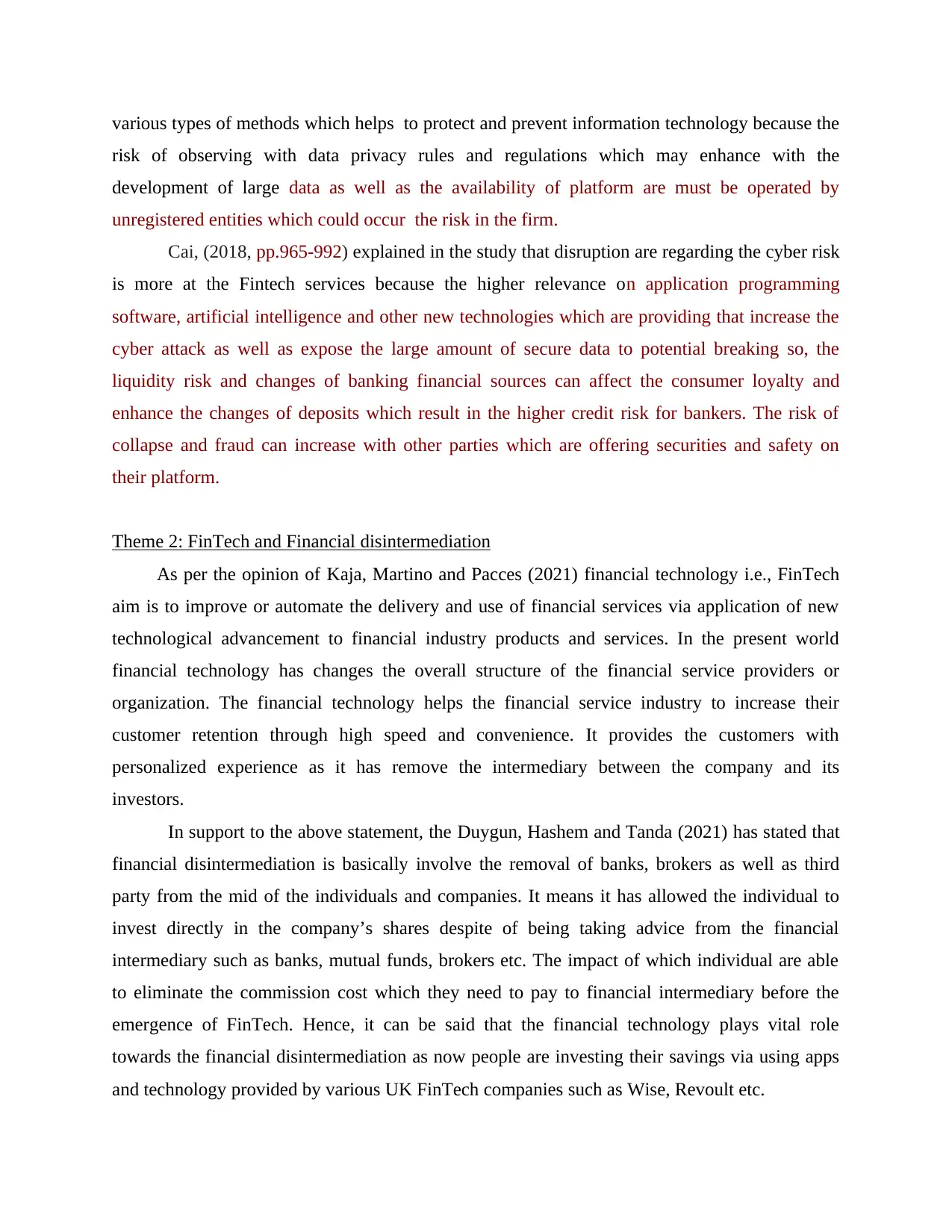
various types of methods which helps to protect and prevent information technology because the
risk of observing with data privacy rules and regulations which may enhance with the
development of large data as well as the availability of platform are must be operated by
unregistered entities which could occur the risk in the firm.
Cai, (2018, pp.965-992) explained in the study that disruption are regarding the cyber risk
is more at the Fintech services because the higher relevance on application programming
software, artificial intelligence and other new technologies which are providing that increase the
cyber attack as well as expose the large amount of secure data to potential breaking so, the
liquidity risk and changes of banking financial sources can affect the consumer loyalty and
enhance the changes of deposits which result in the higher credit risk for bankers. The risk of
collapse and fraud can increase with other parties which are offering securities and safety on
their platform.
Theme 2: FinTech and Financial disintermediation
As per the opinion of Kaja, Martino and Pacces (2021) financial technology i.e., FinTech
aim is to improve or automate the delivery and use of financial services via application of new
technological advancement to financial industry products and services. In the present world
financial technology has changes the overall structure of the financial service providers or
organization. The financial technology helps the financial service industry to increase their
customer retention through high speed and convenience. It provides the customers with
personalized experience as it has remove the intermediary between the company and its
investors.
In support to the above statement, the Duygun, Hashem and Tanda (2021) has stated that
financial disintermediation is basically involve the removal of banks, brokers as well as third
party from the mid of the individuals and companies. It means it has allowed the individual to
invest directly in the company’s shares despite of being taking advice from the financial
intermediary such as banks, mutual funds, brokers etc. The impact of which individual are able
to eliminate the commission cost which they need to pay to financial intermediary before the
emergence of FinTech. Hence, it can be said that the financial technology plays vital role
towards the financial disintermediation as now people are investing their savings via using apps
and technology provided by various UK FinTech companies such as Wise, Revoult etc.
risk of observing with data privacy rules and regulations which may enhance with the
development of large data as well as the availability of platform are must be operated by
unregistered entities which could occur the risk in the firm.
Cai, (2018, pp.965-992) explained in the study that disruption are regarding the cyber risk
is more at the Fintech services because the higher relevance on application programming
software, artificial intelligence and other new technologies which are providing that increase the
cyber attack as well as expose the large amount of secure data to potential breaking so, the
liquidity risk and changes of banking financial sources can affect the consumer loyalty and
enhance the changes of deposits which result in the higher credit risk for bankers. The risk of
collapse and fraud can increase with other parties which are offering securities and safety on
their platform.
Theme 2: FinTech and Financial disintermediation
As per the opinion of Kaja, Martino and Pacces (2021) financial technology i.e., FinTech
aim is to improve or automate the delivery and use of financial services via application of new
technological advancement to financial industry products and services. In the present world
financial technology has changes the overall structure of the financial service providers or
organization. The financial technology helps the financial service industry to increase their
customer retention through high speed and convenience. It provides the customers with
personalized experience as it has remove the intermediary between the company and its
investors.
In support to the above statement, the Duygun, Hashem and Tanda (2021) has stated that
financial disintermediation is basically involve the removal of banks, brokers as well as third
party from the mid of the individuals and companies. It means it has allowed the individual to
invest directly in the company’s shares despite of being taking advice from the financial
intermediary such as banks, mutual funds, brokers etc. The impact of which individual are able
to eliminate the commission cost which they need to pay to financial intermediary before the
emergence of FinTech. Hence, it can be said that the financial technology plays vital role
towards the financial disintermediation as now people are investing their savings via using apps
and technology provided by various UK FinTech companies such as Wise, Revoult etc.
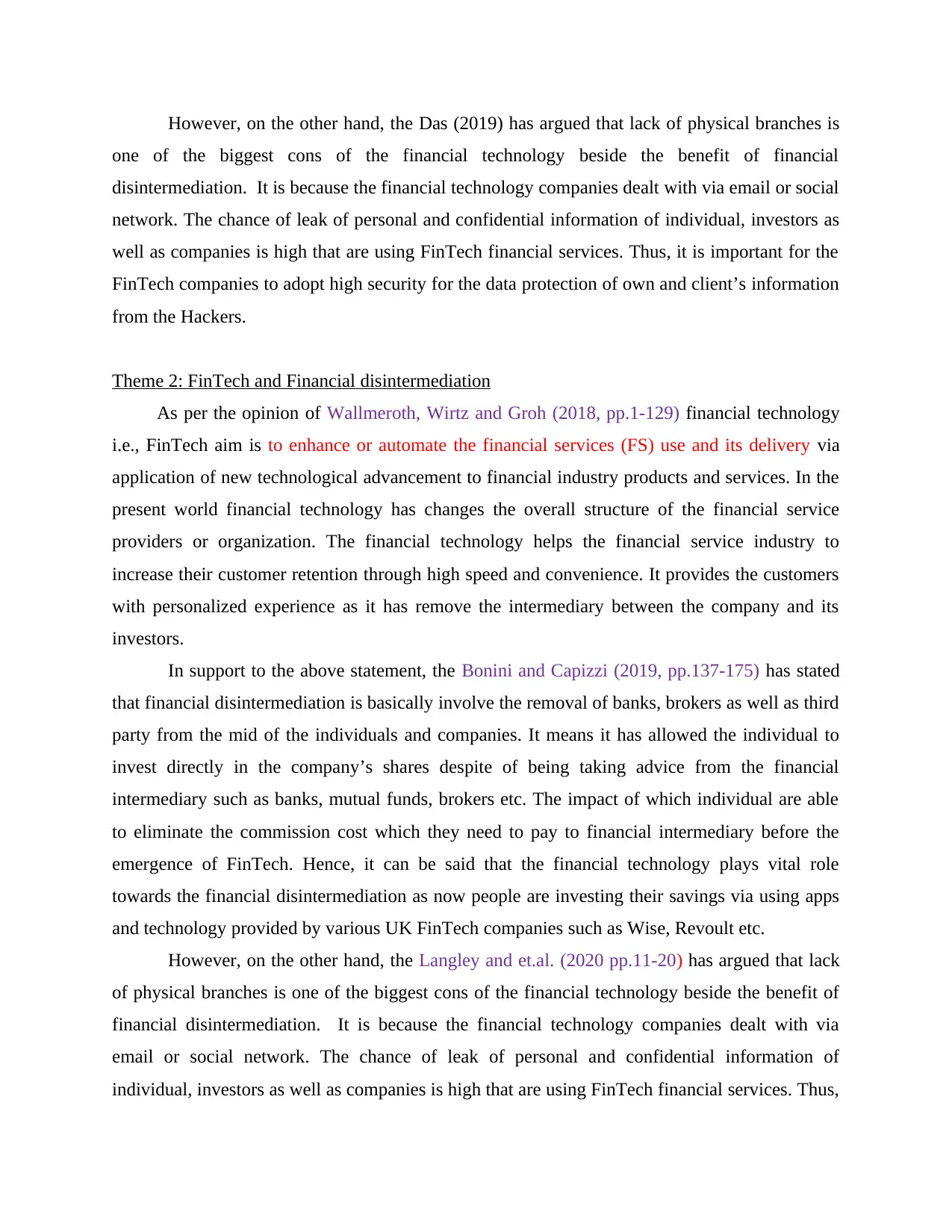
However, on the other hand, the Das (2019) has argued that lack of physical branches is
one of the biggest cons of the financial technology beside the benefit of financial
disintermediation. It is because the financial technology companies dealt with via email or social
network. The chance of leak of personal and confidential information of individual, investors as
well as companies is high that are using FinTech financial services. Thus, it is important for the
FinTech companies to adopt high security for the data protection of own and client’s information
from the Hackers.
Theme 2: FinTech and Financial disintermediation
As per the opinion of Wallmeroth, Wirtz and Groh (2018, pp.1-129) financial technology
i.e., FinTech aim is to enhance or automate the financial services (FS) use and its delivery via
application of new technological advancement to financial industry products and services. In the
present world financial technology has changes the overall structure of the financial service
providers or organization. The financial technology helps the financial service industry to
increase their customer retention through high speed and convenience. It provides the customers
with personalized experience as it has remove the intermediary between the company and its
investors.
In support to the above statement, the Bonini and Capizzi (2019, pp.137-175) has stated
that financial disintermediation is basically involve the removal of banks, brokers as well as third
party from the mid of the individuals and companies. It means it has allowed the individual to
invest directly in the company’s shares despite of being taking advice from the financial
intermediary such as banks, mutual funds, brokers etc. The impact of which individual are able
to eliminate the commission cost which they need to pay to financial intermediary before the
emergence of FinTech. Hence, it can be said that the financial technology plays vital role
towards the financial disintermediation as now people are investing their savings via using apps
and technology provided by various UK FinTech companies such as Wise, Revoult etc.
However, on the other hand, the Langley and et.al. (2020 pp.11-20) has argued that lack
of physical branches is one of the biggest cons of the financial technology beside the benefit of
financial disintermediation. It is because the financial technology companies dealt with via
email or social network. The chance of leak of personal and confidential information of
individual, investors as well as companies is high that are using FinTech financial services. Thus,
one of the biggest cons of the financial technology beside the benefit of financial
disintermediation. It is because the financial technology companies dealt with via email or social
network. The chance of leak of personal and confidential information of individual, investors as
well as companies is high that are using FinTech financial services. Thus, it is important for the
FinTech companies to adopt high security for the data protection of own and client’s information
from the Hackers.
Theme 2: FinTech and Financial disintermediation
As per the opinion of Wallmeroth, Wirtz and Groh (2018, pp.1-129) financial technology
i.e., FinTech aim is to enhance or automate the financial services (FS) use and its delivery via
application of new technological advancement to financial industry products and services. In the
present world financial technology has changes the overall structure of the financial service
providers or organization. The financial technology helps the financial service industry to
increase their customer retention through high speed and convenience. It provides the customers
with personalized experience as it has remove the intermediary between the company and its
investors.
In support to the above statement, the Bonini and Capizzi (2019, pp.137-175) has stated
that financial disintermediation is basically involve the removal of banks, brokers as well as third
party from the mid of the individuals and companies. It means it has allowed the individual to
invest directly in the company’s shares despite of being taking advice from the financial
intermediary such as banks, mutual funds, brokers etc. The impact of which individual are able
to eliminate the commission cost which they need to pay to financial intermediary before the
emergence of FinTech. Hence, it can be said that the financial technology plays vital role
towards the financial disintermediation as now people are investing their savings via using apps
and technology provided by various UK FinTech companies such as Wise, Revoult etc.
However, on the other hand, the Langley and et.al. (2020 pp.11-20) has argued that lack
of physical branches is one of the biggest cons of the financial technology beside the benefit of
financial disintermediation. It is because the financial technology companies dealt with via
email or social network. The chance of leak of personal and confidential information of
individual, investors as well as companies is high that are using FinTech financial services. Thus,
⊘ This is a preview!⊘
Do you want full access?
Subscribe today to unlock all pages.

Trusted by 1+ million students worldwide
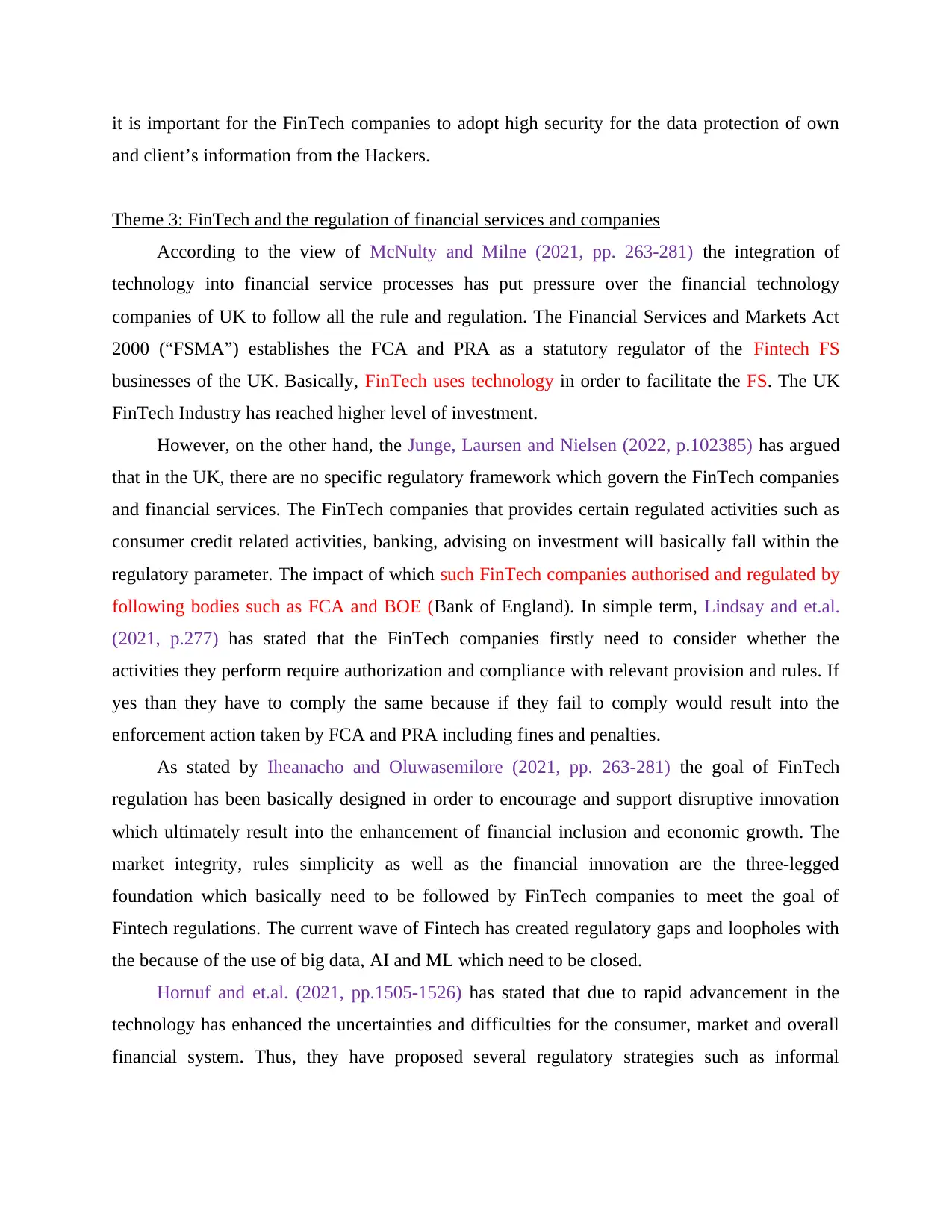
it is important for the FinTech companies to adopt high security for the data protection of own
and client’s information from the Hackers.
Theme 3: FinTech and the regulation of financial services and companies
According to the view of McNulty and Milne (2021, pp. 263-281) the integration of
technology into financial service processes has put pressure over the financial technology
companies of UK to follow all the rule and regulation. The Financial Services and Markets Act
2000 (“FSMA”) establishes the FCA and PRA as a statutory regulator of the Fintech FS
businesses of the UK. Basically, FinTech uses technology in order to facilitate the FS. The UK
FinTech Industry has reached higher level of investment.
However, on the other hand, the Junge, Laursen and Nielsen (2022, p.102385) has argued
that in the UK, there are no specific regulatory framework which govern the FinTech companies
and financial services. The FinTech companies that provides certain regulated activities such as
consumer credit related activities, banking, advising on investment will basically fall within the
regulatory parameter. The impact of which such FinTech companies authorised and regulated by
following bodies such as FCA and BOE (Bank of England). In simple term, Lindsay and et.al.
(2021, p.277) has stated that the FinTech companies firstly need to consider whether the
activities they perform require authorization and compliance with relevant provision and rules. If
yes than they have to comply the same because if they fail to comply would result into the
enforcement action taken by FCA and PRA including fines and penalties.
As stated by Iheanacho and Oluwasemilore (2021, pp. 263-281) the goal of FinTech
regulation has been basically designed in order to encourage and support disruptive innovation
which ultimately result into the enhancement of financial inclusion and economic growth. The
market integrity, rules simplicity as well as the financial innovation are the three-legged
foundation which basically need to be followed by FinTech companies to meet the goal of
Fintech regulations. The current wave of Fintech has created regulatory gaps and loopholes with
the because of the use of big data, AI and ML which need to be closed.
Hornuf and et.al. (2021, pp.1505-1526) has stated that due to rapid advancement in the
technology has enhanced the uncertainties and difficulties for the consumer, market and overall
financial system. Thus, they have proposed several regulatory strategies such as informal
and client’s information from the Hackers.
Theme 3: FinTech and the regulation of financial services and companies
According to the view of McNulty and Milne (2021, pp. 263-281) the integration of
technology into financial service processes has put pressure over the financial technology
companies of UK to follow all the rule and regulation. The Financial Services and Markets Act
2000 (“FSMA”) establishes the FCA and PRA as a statutory regulator of the Fintech FS
businesses of the UK. Basically, FinTech uses technology in order to facilitate the FS. The UK
FinTech Industry has reached higher level of investment.
However, on the other hand, the Junge, Laursen and Nielsen (2022, p.102385) has argued
that in the UK, there are no specific regulatory framework which govern the FinTech companies
and financial services. The FinTech companies that provides certain regulated activities such as
consumer credit related activities, banking, advising on investment will basically fall within the
regulatory parameter. The impact of which such FinTech companies authorised and regulated by
following bodies such as FCA and BOE (Bank of England). In simple term, Lindsay and et.al.
(2021, p.277) has stated that the FinTech companies firstly need to consider whether the
activities they perform require authorization and compliance with relevant provision and rules. If
yes than they have to comply the same because if they fail to comply would result into the
enforcement action taken by FCA and PRA including fines and penalties.
As stated by Iheanacho and Oluwasemilore (2021, pp. 263-281) the goal of FinTech
regulation has been basically designed in order to encourage and support disruptive innovation
which ultimately result into the enhancement of financial inclusion and economic growth. The
market integrity, rules simplicity as well as the financial innovation are the three-legged
foundation which basically need to be followed by FinTech companies to meet the goal of
Fintech regulations. The current wave of Fintech has created regulatory gaps and loopholes with
the because of the use of big data, AI and ML which need to be closed.
Hornuf and et.al. (2021, pp.1505-1526) has stated that due to rapid advancement in the
technology has enhanced the uncertainties and difficulties for the consumer, market and overall
financial system. Thus, they have proposed several regulatory strategies such as informal
Paraphrase This Document
Need a fresh take? Get an instant paraphrase of this document with our AI Paraphraser
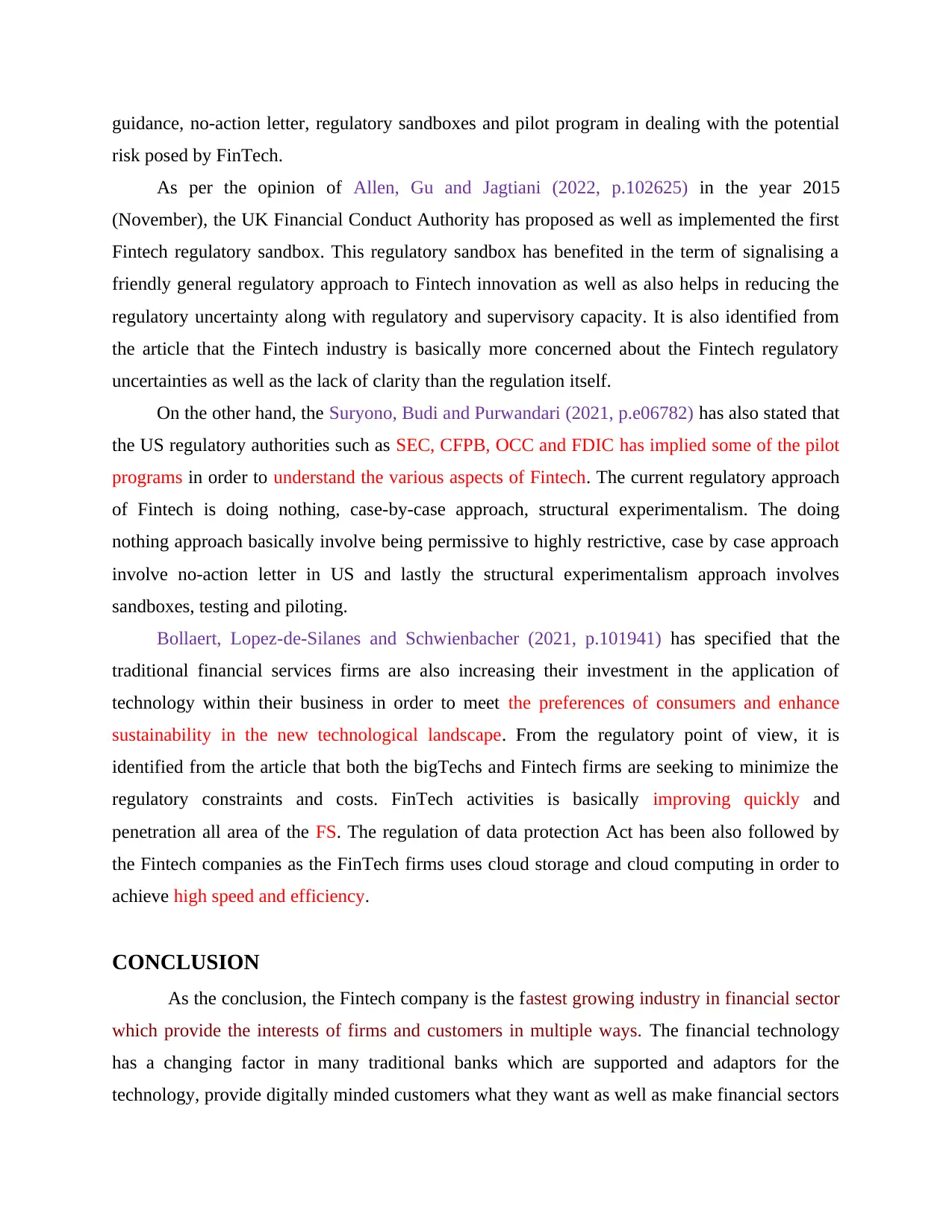
guidance, no-action letter, regulatory sandboxes and pilot program in dealing with the potential
risk posed by FinTech.
As per the opinion of Allen, Gu and Jagtiani (2022, p.102625) in the year 2015
(November), the UK Financial Conduct Authority has proposed as well as implemented the first
Fintech regulatory sandbox. This regulatory sandbox has benefited in the term of signalising a
friendly general regulatory approach to Fintech innovation as well as also helps in reducing the
regulatory uncertainty along with regulatory and supervisory capacity. It is also identified from
the article that the Fintech industry is basically more concerned about the Fintech regulatory
uncertainties as well as the lack of clarity than the regulation itself.
On the other hand, the Suryono, Budi and Purwandari (2021, p.e06782) has also stated that
the US regulatory authorities such as SEC, CFPB, OCC and FDIC has implied some of the pilot
programs in order to understand the various aspects of Fintech. The current regulatory approach
of Fintech is doing nothing, case-by-case approach, structural experimentalism. The doing
nothing approach basically involve being permissive to highly restrictive, case by case approach
involve no-action letter in US and lastly the structural experimentalism approach involves
sandboxes, testing and piloting.
Bollaert, Lopez-de-Silanes and Schwienbacher (2021, p.101941) has specified that the
traditional financial services firms are also increasing their investment in the application of
technology within their business in order to meet the preferences of consumers and enhance
sustainability in the new technological landscape. From the regulatory point of view, it is
identified from the article that both the bigTechs and Fintech firms are seeking to minimize the
regulatory constraints and costs. FinTech activities is basically improving quickly and
penetration all area of the FS. The regulation of data protection Act has been also followed by
the Fintech companies as the FinTech firms uses cloud storage and cloud computing in order to
achieve high speed and efficiency.
CONCLUSION
As the conclusion, the Fintech company is the fastest growing industry in financial sector
which provide the interests of firms and customers in multiple ways. The financial technology
has a changing factor in many traditional banks which are supported and adaptors for the
technology, provide digitally minded customers what they want as well as make financial sectors
risk posed by FinTech.
As per the opinion of Allen, Gu and Jagtiani (2022, p.102625) in the year 2015
(November), the UK Financial Conduct Authority has proposed as well as implemented the first
Fintech regulatory sandbox. This regulatory sandbox has benefited in the term of signalising a
friendly general regulatory approach to Fintech innovation as well as also helps in reducing the
regulatory uncertainty along with regulatory and supervisory capacity. It is also identified from
the article that the Fintech industry is basically more concerned about the Fintech regulatory
uncertainties as well as the lack of clarity than the regulation itself.
On the other hand, the Suryono, Budi and Purwandari (2021, p.e06782) has also stated that
the US regulatory authorities such as SEC, CFPB, OCC and FDIC has implied some of the pilot
programs in order to understand the various aspects of Fintech. The current regulatory approach
of Fintech is doing nothing, case-by-case approach, structural experimentalism. The doing
nothing approach basically involve being permissive to highly restrictive, case by case approach
involve no-action letter in US and lastly the structural experimentalism approach involves
sandboxes, testing and piloting.
Bollaert, Lopez-de-Silanes and Schwienbacher (2021, p.101941) has specified that the
traditional financial services firms are also increasing their investment in the application of
technology within their business in order to meet the preferences of consumers and enhance
sustainability in the new technological landscape. From the regulatory point of view, it is
identified from the article that both the bigTechs and Fintech firms are seeking to minimize the
regulatory constraints and costs. FinTech activities is basically improving quickly and
penetration all area of the FS. The regulation of data protection Act has been also followed by
the Fintech companies as the FinTech firms uses cloud storage and cloud computing in order to
achieve high speed and efficiency.
CONCLUSION
As the conclusion, the Fintech company is the fastest growing industry in financial sector
which provide the interests of firms and customers in multiple ways. The financial technology
has a changing factor in many traditional banks which are supported and adaptors for the
technology, provide digitally minded customers what they want as well as make financial sectors

safe, effective and more efficient. In the conclusion, Fintech is the effective developing
technology sector. The authors are sure that the development and evolution of Fintech with the
new technology service and success of banks are really basis for the formation of financial
companies of a new generation with the regulation of financial institutions.
technology sector. The authors are sure that the development and evolution of Fintech with the
new technology service and success of banks are really basis for the formation of financial
companies of a new generation with the regulation of financial institutions.
⊘ This is a preview!⊘
Do you want full access?
Subscribe today to unlock all pages.

Trusted by 1+ million students worldwide
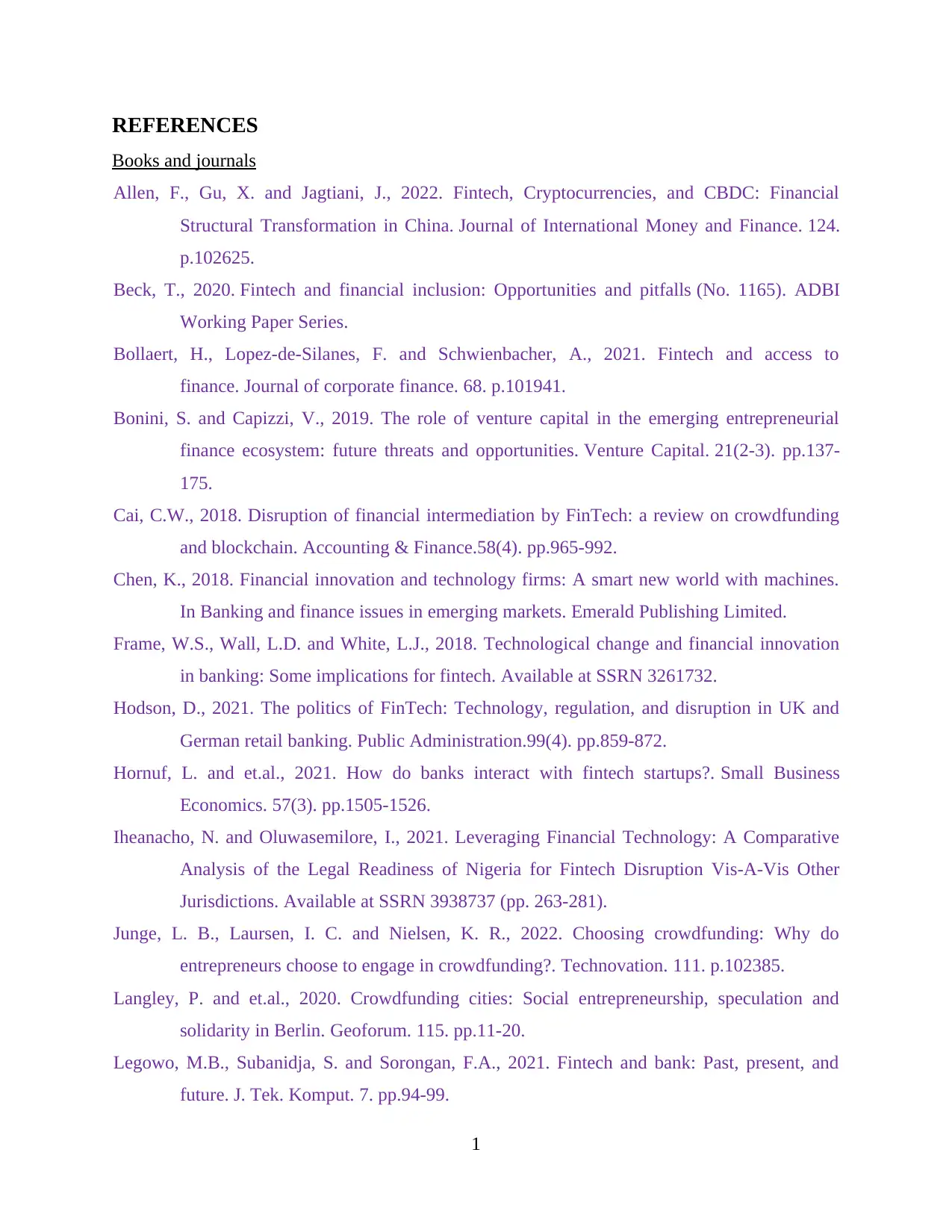
REFERENCES
Books and journals
Allen, F., Gu, X. and Jagtiani, J., 2022. Fintech, Cryptocurrencies, and CBDC: Financial
Structural Transformation in China. Journal of International Money and Finance. 124.
p.102625.
Beck, T., 2020. Fintech and financial inclusion: Opportunities and pitfalls (No. 1165). ADBI
Working Paper Series.
Bollaert, H., Lopez-de-Silanes, F. and Schwienbacher, A., 2021. Fintech and access to
finance. Journal of corporate finance. 68. p.101941.
Bonini, S. and Capizzi, V., 2019. The role of venture capital in the emerging entrepreneurial
finance ecosystem: future threats and opportunities. Venture Capital. 21(2-3). pp.137-
175.
Cai, C.W., 2018. Disruption of financial intermediation by FinTech: a review on crowdfunding
and blockchain. Accounting & Finance.58(4). pp.965-992.
Chen, K., 2018. Financial innovation and technology firms: A smart new world with machines.
In Banking and finance issues in emerging markets. Emerald Publishing Limited.
Frame, W.S., Wall, L.D. and White, L.J., 2018. Technological change and financial innovation
in banking: Some implications for fintech. Available at SSRN 3261732.
Hodson, D., 2021. The politics of FinTech: Technology, regulation, and disruption in UK and
German retail banking. Public Administration.99(4). pp.859-872.
Hornuf, L. and et.al., 2021. How do banks interact with fintech startups?. Small Business
Economics. 57(3). pp.1505-1526.
Iheanacho, N. and Oluwasemilore, I., 2021. Leveraging Financial Technology: A Comparative
Analysis of the Legal Readiness of Nigeria for Fintech Disruption Vis-A-Vis Other
Jurisdictions. Available at SSRN 3938737 (pp. 263-281).
Junge, L. B., Laursen, I. C. and Nielsen, K. R., 2022. Choosing crowdfunding: Why do
entrepreneurs choose to engage in crowdfunding?. Technovation. 111. p.102385.
Langley, P. and et.al., 2020. Crowdfunding cities: Social entrepreneurship, speculation and
solidarity in Berlin. Geoforum. 115. pp.11-20.
Legowo, M.B., Subanidja, S. and Sorongan, F.A., 2021. Fintech and bank: Past, present, and
future. J. Tek. Komput. 7. pp.94-99.
1
Books and journals
Allen, F., Gu, X. and Jagtiani, J., 2022. Fintech, Cryptocurrencies, and CBDC: Financial
Structural Transformation in China. Journal of International Money and Finance. 124.
p.102625.
Beck, T., 2020. Fintech and financial inclusion: Opportunities and pitfalls (No. 1165). ADBI
Working Paper Series.
Bollaert, H., Lopez-de-Silanes, F. and Schwienbacher, A., 2021. Fintech and access to
finance. Journal of corporate finance. 68. p.101941.
Bonini, S. and Capizzi, V., 2019. The role of venture capital in the emerging entrepreneurial
finance ecosystem: future threats and opportunities. Venture Capital. 21(2-3). pp.137-
175.
Cai, C.W., 2018. Disruption of financial intermediation by FinTech: a review on crowdfunding
and blockchain. Accounting & Finance.58(4). pp.965-992.
Chen, K., 2018. Financial innovation and technology firms: A smart new world with machines.
In Banking and finance issues in emerging markets. Emerald Publishing Limited.
Frame, W.S., Wall, L.D. and White, L.J., 2018. Technological change and financial innovation
in banking: Some implications for fintech. Available at SSRN 3261732.
Hodson, D., 2021. The politics of FinTech: Technology, regulation, and disruption in UK and
German retail banking. Public Administration.99(4). pp.859-872.
Hornuf, L. and et.al., 2021. How do banks interact with fintech startups?. Small Business
Economics. 57(3). pp.1505-1526.
Iheanacho, N. and Oluwasemilore, I., 2021. Leveraging Financial Technology: A Comparative
Analysis of the Legal Readiness of Nigeria for Fintech Disruption Vis-A-Vis Other
Jurisdictions. Available at SSRN 3938737 (pp. 263-281).
Junge, L. B., Laursen, I. C. and Nielsen, K. R., 2022. Choosing crowdfunding: Why do
entrepreneurs choose to engage in crowdfunding?. Technovation. 111. p.102385.
Langley, P. and et.al., 2020. Crowdfunding cities: Social entrepreneurship, speculation and
solidarity in Berlin. Geoforum. 115. pp.11-20.
Legowo, M.B., Subanidja, S. and Sorongan, F.A., 2021. Fintech and bank: Past, present, and
future. J. Tek. Komput. 7. pp.94-99.
1
Paraphrase This Document
Need a fresh take? Get an instant paraphrase of this document with our AI Paraphraser
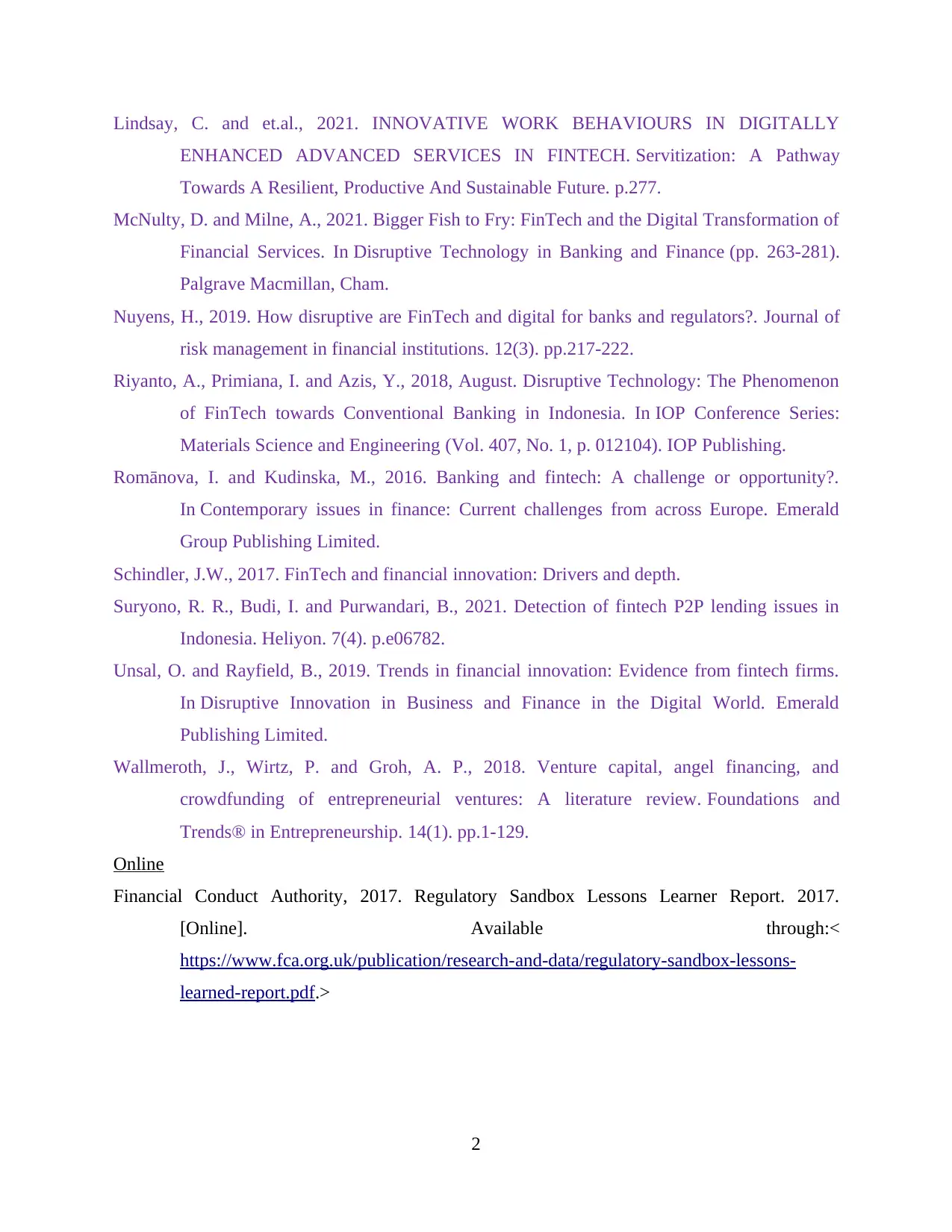
Lindsay, C. and et.al., 2021. INNOVATIVE WORK BEHAVIOURS IN DIGITALLY
ENHANCED ADVANCED SERVICES IN FINTECH. Servitization: A Pathway
Towards A Resilient, Productive And Sustainable Future. p.277.
McNulty, D. and Milne, A., 2021. Bigger Fish to Fry: FinTech and the Digital Transformation of
Financial Services. In Disruptive Technology in Banking and Finance (pp. 263-281).
Palgrave Macmillan, Cham.
Nuyens, H., 2019. How disruptive are FinTech and digital for banks and regulators?. Journal of
risk management in financial institutions. 12(3). pp.217-222.
Riyanto, A., Primiana, I. and Azis, Y., 2018, August. Disruptive Technology: The Phenomenon
of FinTech towards Conventional Banking in Indonesia. In IOP Conference Series:
Materials Science and Engineering (Vol. 407, No. 1, p. 012104). IOP Publishing.
Romānova, I. and Kudinska, M., 2016. Banking and fintech: A challenge or opportunity?.
In Contemporary issues in finance: Current challenges from across Europe. Emerald
Group Publishing Limited.
Schindler, J.W., 2017. FinTech and financial innovation: Drivers and depth.
Suryono, R. R., Budi, I. and Purwandari, B., 2021. Detection of fintech P2P lending issues in
Indonesia. Heliyon. 7(4). p.e06782.
Unsal, O. and Rayfield, B., 2019. Trends in financial innovation: Evidence from fintech firms.
In Disruptive Innovation in Business and Finance in the Digital World. Emerald
Publishing Limited.
Wallmeroth, J., Wirtz, P. and Groh, A. P., 2018. Venture capital, angel financing, and
crowdfunding of entrepreneurial ventures: A literature review. Foundations and
Trends® in Entrepreneurship. 14(1). pp.1-129.
Online
Financial Conduct Authority, 2017. Regulatory Sandbox Lessons Learner Report. 2017.
[Online]. Available through:<
https://www.fca.org.uk/publication/research-and-data/regulatory-sandbox-lessons-
learned-report.pdf.>
2
ENHANCED ADVANCED SERVICES IN FINTECH. Servitization: A Pathway
Towards A Resilient, Productive And Sustainable Future. p.277.
McNulty, D. and Milne, A., 2021. Bigger Fish to Fry: FinTech and the Digital Transformation of
Financial Services. In Disruptive Technology in Banking and Finance (pp. 263-281).
Palgrave Macmillan, Cham.
Nuyens, H., 2019. How disruptive are FinTech and digital for banks and regulators?. Journal of
risk management in financial institutions. 12(3). pp.217-222.
Riyanto, A., Primiana, I. and Azis, Y., 2018, August. Disruptive Technology: The Phenomenon
of FinTech towards Conventional Banking in Indonesia. In IOP Conference Series:
Materials Science and Engineering (Vol. 407, No. 1, p. 012104). IOP Publishing.
Romānova, I. and Kudinska, M., 2016. Banking and fintech: A challenge or opportunity?.
In Contemporary issues in finance: Current challenges from across Europe. Emerald
Group Publishing Limited.
Schindler, J.W., 2017. FinTech and financial innovation: Drivers and depth.
Suryono, R. R., Budi, I. and Purwandari, B., 2021. Detection of fintech P2P lending issues in
Indonesia. Heliyon. 7(4). p.e06782.
Unsal, O. and Rayfield, B., 2019. Trends in financial innovation: Evidence from fintech firms.
In Disruptive Innovation in Business and Finance in the Digital World. Emerald
Publishing Limited.
Wallmeroth, J., Wirtz, P. and Groh, A. P., 2018. Venture capital, angel financing, and
crowdfunding of entrepreneurial ventures: A literature review. Foundations and
Trends® in Entrepreneurship. 14(1). pp.1-129.
Online
Financial Conduct Authority, 2017. Regulatory Sandbox Lessons Learner Report. 2017.
[Online]. Available through:<
https://www.fca.org.uk/publication/research-and-data/regulatory-sandbox-lessons-
learned-report.pdf.>
2
1 out of 11
Related Documents
Your All-in-One AI-Powered Toolkit for Academic Success.
+13062052269
info@desklib.com
Available 24*7 on WhatsApp / Email
![[object Object]](/_next/static/media/star-bottom.7253800d.svg)
Unlock your academic potential
Copyright © 2020–2025 A2Z Services. All Rights Reserved. Developed and managed by ZUCOL.





